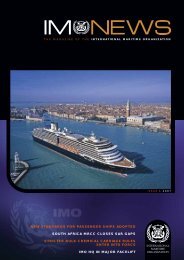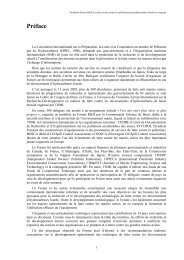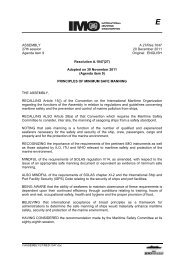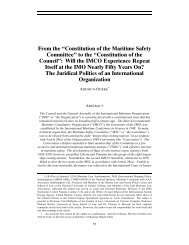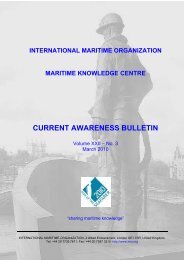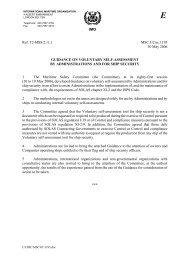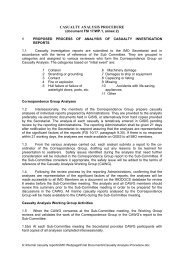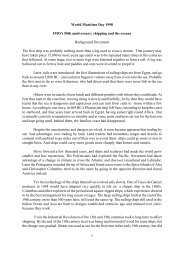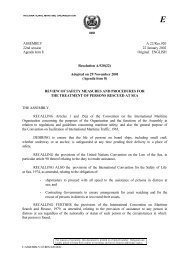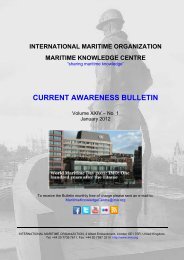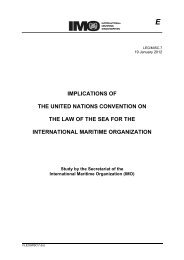What it is - International Maritime Organization
What it is - International Maritime Organization
What it is - International Maritime Organization
Create successful ePaper yourself
Turn your PDF publications into a flip-book with our unique Google optimized e-Paper software.
• Code of Safety for Dynamically<br />
Supported Craft (1977);<br />
• Code for the Construction and<br />
Equipment of Mobile Offshore<br />
Drilling Un<strong>it</strong>s (MODU Code) (1979);<br />
• Code on No<strong>is</strong>e Levels on Board<br />
Ships (1981);<br />
• Code of Safety for Nuclear<br />
Merchant Ships (1981);<br />
• Code of Safety for Special Purpose<br />
Ships (1983);<br />
• <strong>International</strong> Gas Carrier Code<br />
(IGC Code) (1983; mandatory under<br />
SOLAS);<br />
• <strong>International</strong> Bulk Chemicals Code<br />
(IBC Code) (1983; mandatory under<br />
SOLAS and MARPOL);<br />
• Code of Safety for Diving Systems<br />
(1983);<br />
• <strong>International</strong> Code for the<br />
Safe Carriage of Grain in Bulk<br />
(<strong>International</strong> Grain Code) (1991;<br />
mandatory under SOLAS);<br />
• <strong>International</strong> Safety Management<br />
Code (ISM Code) (1993; mandatory<br />
under SOLAS);<br />
• <strong>International</strong> Code of Safety for<br />
High-Speed Craft (HSC Code)<br />
(1994 and 2000; mandatory under<br />
SOLAS);<br />
• <strong>International</strong> Life-Saving Appliance<br />
Code (LSA Code) (1996; mandatory<br />
under SOLAS);<br />
• <strong>International</strong> Code for Application<br />
of Fire Test Procedures (FTP Code)<br />
(1996; mandatory under SOLAS);<br />
• Technical Code on Control of<br />
Em<strong>is</strong>sion of N<strong>it</strong>rogen Oxides<br />
from Marine Diesel Engines (NO X<br />
Technical Code – 1997; mandatory<br />
under MARPOL).<br />
Other important recommendations<br />
have dealt w<strong>it</strong>h such matters as traffic<br />
separation schemes (which separate<br />
ships moving in oppos<strong>it</strong>e directions<br />
by creating a central prohib<strong>it</strong>ed<br />
area); the adoption of technical<br />
manuals such as the Standard Marine<br />
Communication Phrases (SMCP), the<br />
<strong>International</strong> Aeronautical and Mar<strong>it</strong>ime<br />
Search and Rescue Manual (jointly<br />
w<strong>it</strong>h the <strong>International</strong> Civil Aviation<br />
<strong>Organization</strong>) and the Manual on Oil<br />
Pollution; crew training; performance<br />
standards for shipborne equipment;<br />
and many other matters. There are also<br />
guidelines to help the implementation<br />
of particular conventions and<br />
instruments.<br />
16<br />
<strong>What</strong> <strong>it</strong> <strong>is</strong>



